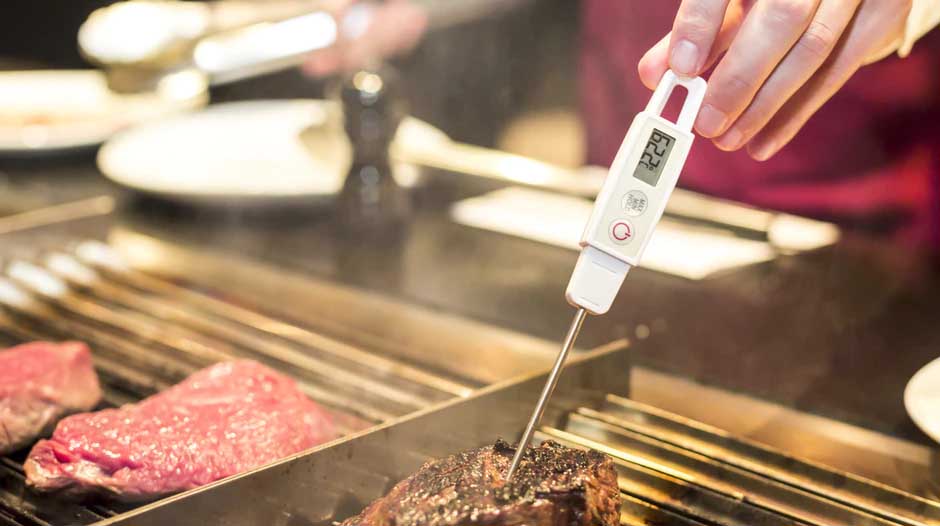Meat thermometers are essential for both home and commercial cooking. The instruments ensure you have an accurate reading of the quality of meat as cooked or not. The veracity of the meat temperature protects you from ingesting uncooked meat ultimately saving you from food poisoning and bacterial infections.
A thermometer usually has a gauge that takes readings and a probe that enters the meat. By virtue of penetrating the meat, the probe can transfer Salmonella to another piece of meat if not well cooked. Here is a step-by-step guide on how to clean a meat thermometer the right way.
Why rinsing alone doesn’t clean your thermometer
Rinsing off may seem like a script off elementary science yet it helps albeit to a small degree.
First, the water may not effectively wash away disease-causing bacteria which can’t be seen by the naked eye. Also, rinsing water may have dangerous micro-organisms. However, it does help to a certain degree.
Read Also: Best thermometer for your pizza oven
Using hot soapy water to clean digital thermometers
Public health experts counsel the use of soapy hot water to clean the probes and stem of the thermometer. It is advisable to use hot soapy water due to its ability to get rid of meat grease and surface bacteria.
You can then rinse using cold water. If your thermometer has electrical components like instant-read thermometers ensure you don’t submerge the body since it can result in a short circuit
- Partly submerge the thermometer probe.
- Use soapy water to clean the probe using a soft sponge to pay attention to the sensor probe. Clean the tines (Forked Digital thermometers) with soap and water to remove food particles and grease.
- Focus on the last 1″ tip of the probe (In the case of the digital wireless thermometer).
- Pay attention to the sensor is usually located within the lower 1/4″ of the probe.
- If you are in a hurry you can use alcohol wipes (ensure you let it dry for some moments to avoid oversaturation) or vinegar with soft cotton then leaving it to dry.
- Use a soapy sponge to remove carbon build-up from the end.
- Rinse the probe with cold running water
- Use paper towels or soft clean to dry the probe(Paper towels are advisable since they can’t be reused unlike soft towels).
- Sanitize the thermometer later
Cleaning a glass thermometer
- Glass thermometers are relatively easy to clean manually however they are prone to get broken
- Due to the glass material they visibly stain easily from grease and smoke depending on the type of meat-cooking involved.
- After passing the visible test the next step is cleaning
- Use warm soapy water to wash the thermometer. If you encounter tough stains use cooking spray on the stain (smoke and grease) then wipe it off. Bar soap can do the job however it requires a lot of rinsing to remove the soap stains.
- You can soak the thermometer in the liquid for a while to loosen stubborn grease and smoke stain.
- Dry them up using paper towels
- Sanitize them
Sanitizing your thermometer
Once you clean your meat thermometer, you need to sanitize it. This process ensures that any trace dirt or bacteria are completely gotten ridden off. The process is relatively simple from basic boiling to the use of chemicals like alcohol and chlorine bleach.
Boiling water
Boiling ensures that the trace bacteria are completely killed. However, you need to ensure that the water used is 212-degrees Fahrenheit and your thermometer probe is held in the water for not less than 30 seconds.
Chlorine bleach
- Mix chlorine bleach with water as per instructions provided
- Dip your thermometer probe or stem for a minimum of 10 seconds
- Carry out a final rinse with hot water to remove chlorine residue
Cleaning with alcohol
- Depending on the amount of available alcohol, you can opt to submerge the stem/probe of your thermometer in the solution
- In case you don’t have enough use cotton wool to wipe the stem/probe.
- Let your thermometer dry before using it
Clean your meat thermometer in order to maintain cleanliness and prevent food-related complications. The process highlighted here is simple and cost-effective.
You can always combine a variety of cleaning and sanitizing methods to ensure your thermometer is always clean. Also, cleaning can happen both prior to or after checking the temperature of the meat.

